
Jacques Tardi. Photo: Thesupermat
Artist and writer Keith Page shines a light on the work of the award-winning French artist Jacques Tardi…
Jacques Tardi spent his early years in post-war Germany, his father a career soldier. The atrocities of the 1914-18 war, retold him by his Corsican grandfather, haunted his childhood dreams before becoming one of the major themes that would inspire his work.
He was a student at the School of Fine Arts in Lyon, then the Decorative Arts of Paris, making his comics debut in the weekly Pilote in 1969. His first full-length graphic novel, Rumors on the Rouergue” (scenario Christin, published at Futuropolis in 1976).
Essentially, Jaques Tardi appears to have two main interests; World War One and Paris. His drawing style may be described as a sort of evolution of Hergé’s “clear line” (ligne claire) technique, used in the Tintin stories. A similar close attention to detail is evident and Tardi’s faces are often somewhat cartoon-like.
He does, however, have a great sense of light and shade, something not seen with Hergé. This is sometimes enhanced· to great effect with the use of mechanical tints. Interestingly, some of his effects can be very like those in Giles cartoons.
Tardi’s main World War One work, C’était la guerre des tranchées (It was the War of Trenches), published in 1993, shows great accuracy in the military hardware and also for its extreme violence not seen or probably permitted in the likes of British strips such as Battle‘s “Charley’s War” (that strip, on occasion itself suffering some censorship, especially during its reprint during its run in Eagle. The story is slow paced and appears to be lettered by Tardi himself. It is certainly very grim.
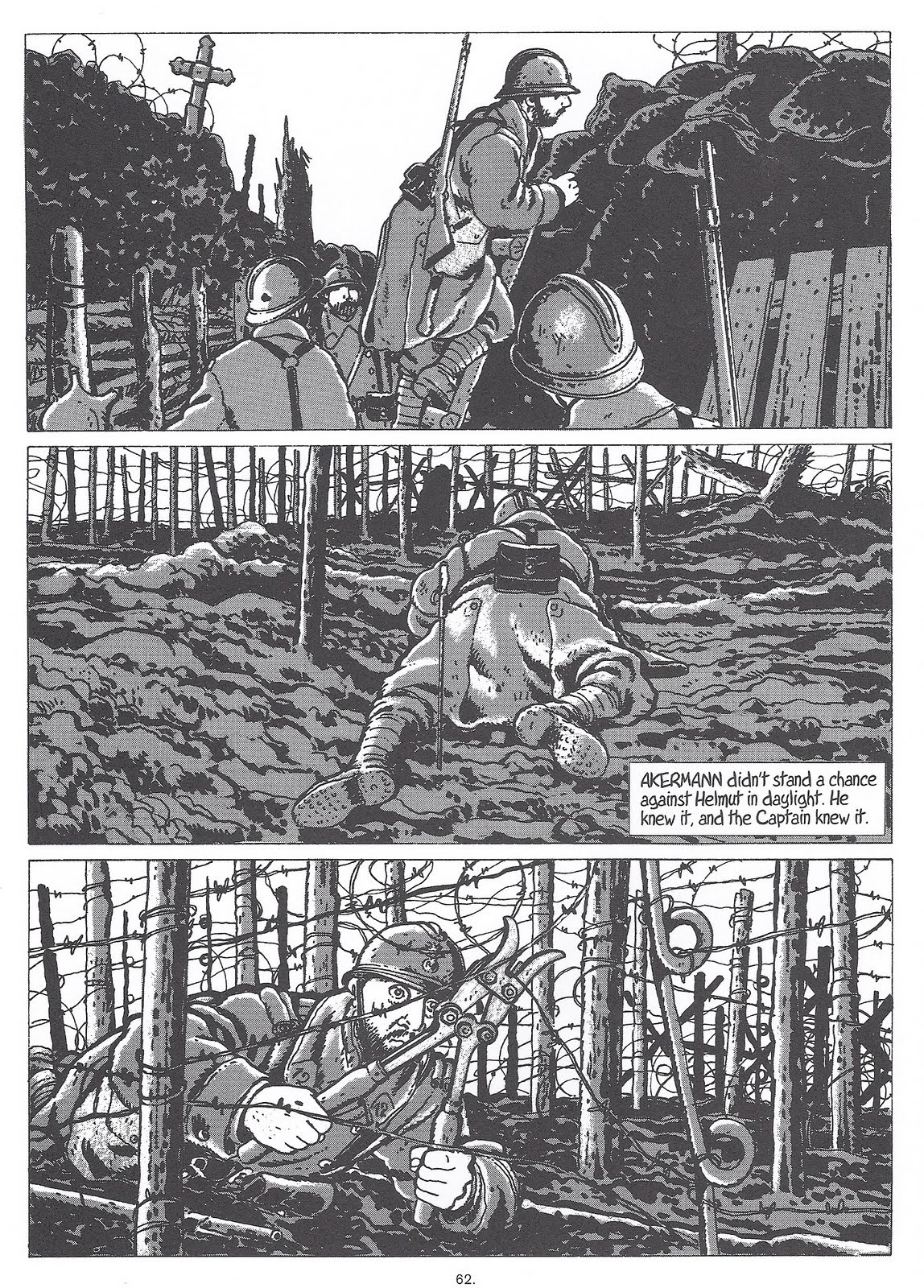

Going back a few years to the early 20th century is the Adele Blanc-Sec series, which is fantastical in the extreme with a touch of comedy. The series features a bewildering variety of themes and adversaries, including a pterodactyl, an Egyptian mummy, a giant octopus and a sort of bionic gorilla, all set in scrupulously accurate scenes of 1900’s Paris. The drawing style is lighter and looser than the World War One book and the characters are very cartoonish.
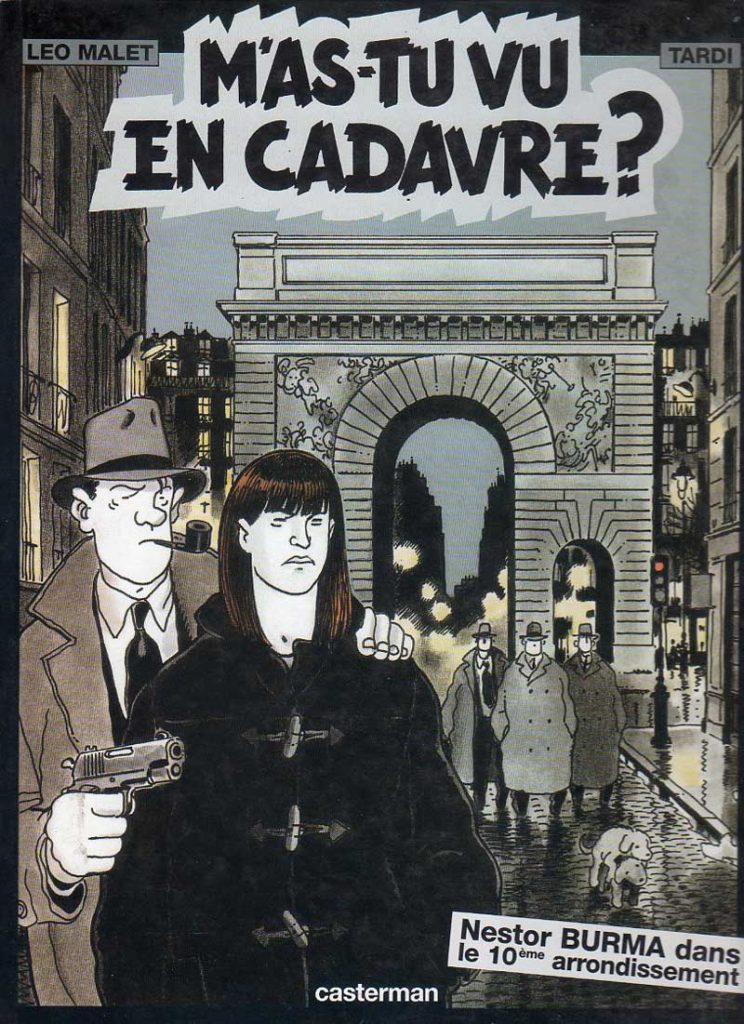
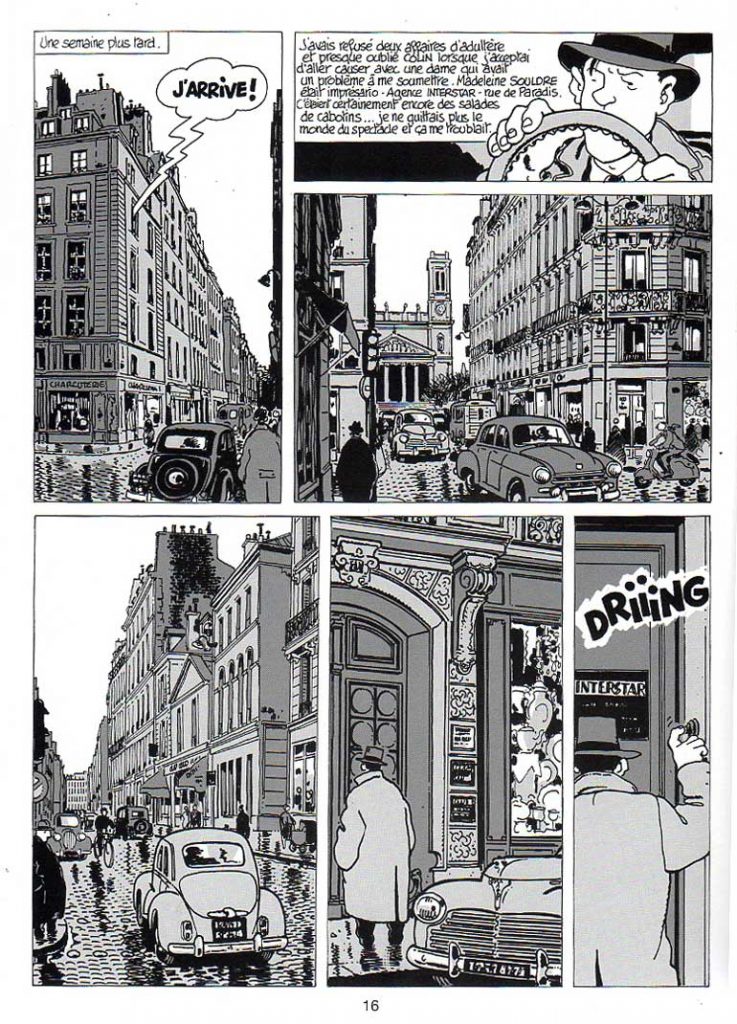 After this, Tardi moved on to probably his most well-known creation, private detective Nestor Burma, adapted from the novels of Leo Malet. Burma first appeared in Brouillard au pont de Tolbiac in 1982, followed in 1988 by the 190-page 120, rue de la Gare which was set largely in wartime Paris. There is one particularly outstanding sequence in this, following a police Citroen Traction Avant driving through a wintry Paris night whilst an RAF air raid is in progress.
After this, Tardi moved on to probably his most well-known creation, private detective Nestor Burma, adapted from the novels of Leo Malet. Burma first appeared in Brouillard au pont de Tolbiac in 1982, followed in 1988 by the 190-page 120, rue de la Gare which was set largely in wartime Paris. There is one particularly outstanding sequence in this, following a police Citroen Traction Avant driving through a wintry Paris night whilst an RAF air raid is in progress.
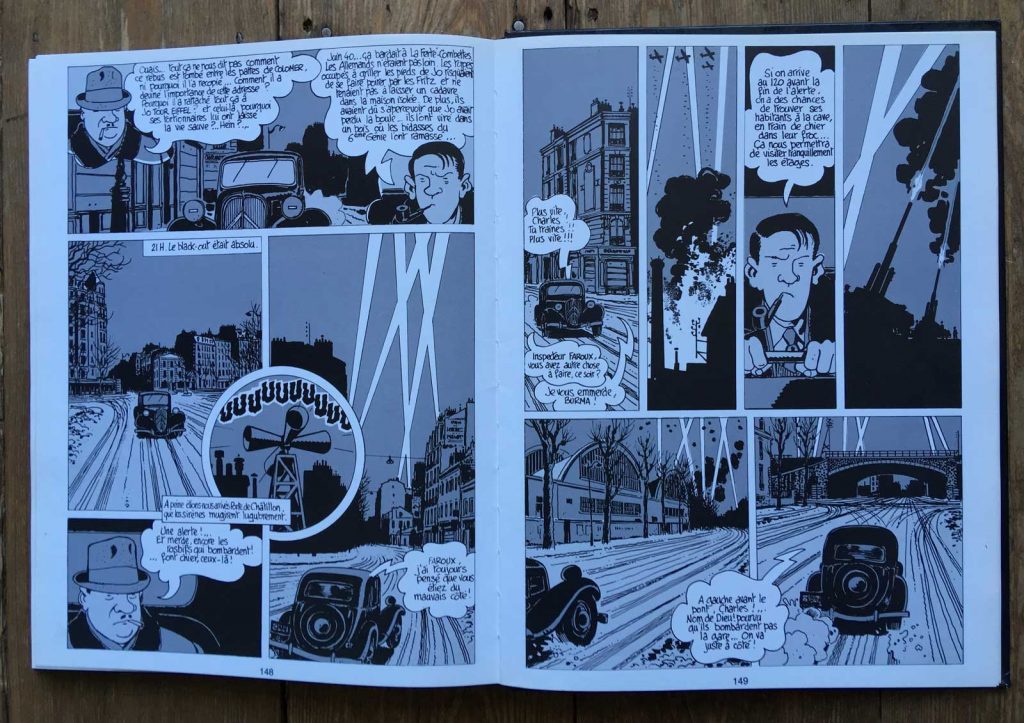

A sequence from 120, rue de la Gare, art by Jacques Tardi
The remainder of the Nestor Burma series is set in the 1950s. Each story is set in a different area of Paris and the street scenes are scrupulously accurate in every way. Even the endpapers show a map of the relevant district and where each incident takes place. Every possible detail like the period ads stuck on Bistro doors is there, and the time spent on research must have been considerable.
The detective theme also features in other books. Le Der des Ders (The Last of the Last) is set in Paris (again) in 1920 and features a soldier returned from World War One. Another 1950s story The Secret of the Strangler is a really odd piece which has two “alternative” endings. Tardi’s later style is even looser and gives the impression of being drawn by a felt -tipped pen.
A somewhat brutal thriller is Le Petit Bleu de la Cote Ouest (which is not really translatable. This is set in the 1970s and is a rare excursion to another part of France.

Art from Le Cri du peuple
 Tardi’s historical masterpiece is the truly monumental adaption of Le Cri du peuple (Cry of the People: The murdered hope) a novel by the writer Jean Vautrin. Set during the violent Paris Commune of 1870 there are some really widescreen cinematic scenes. This must have been a really difficult project and Tardi extracts the maximum from simple black and white drawings. No mechanical tinting or washes in this one. Yes, the drawing does appear to be somewhat rough but the overall effect is impressive.
Tardi’s historical masterpiece is the truly monumental adaption of Le Cri du peuple (Cry of the People: The murdered hope) a novel by the writer Jean Vautrin. Set during the violent Paris Commune of 1870 there are some really widescreen cinematic scenes. This must have been a really difficult project and Tardi extracts the maximum from simple black and white drawings. No mechanical tinting or washes in this one. Yes, the drawing does appear to be somewhat rough but the overall effect is impressive.
Tardi wrote one Nestor Burma story himself and this was entitled (more or less) “The Hangover”. The format is different, probably deliberately, and is A4, in colour. Tardi seems less happy with the use of watercolour which ranges from pretty good to rough. As he said in one interview “l am not a painter”.
Tardi has since returned to the World War Two period with two volumes about his father’s experiences as a prisoner of war. A film clip on the Casterman website shows him following his father’s wartime footsteps and making sketches at various locations.
Many of Tardi’s books (but by no means all) are now published by Fantagraphics Books in English, edited and translated by Fantagraphics’ co-founder Kim Thompson. These include West Coast Blues (Le Petit bleu de la côte ouest), You Are There (Ici Même), It Was the War of the Trenches (C’était la guerre des tranchées), Like a Sniper Lining Up His Shot (La Position du tireur couché) and The Arctic Marauder (Le Démon des glaces).
Apparently, he rarely strays from the working class eastern suburbs of Paris (he did not visit London until 2014, appearing on stage with Pat Mills).

Pat Mills and Jacques Tardi at Foyles Bookshop in November 2014. Photo: Antony Esmond
A feature film, The Extraordinary Adventures of Adele Blanc Sec, directed by Luc Besson, was made a few years ago, but it lacked the charm of the original stories, in my opinion, much like the recent film version of Tintin. The Nestor Burma stories have been taken over by other artists for some while now. I couldn’t recommend them.
 I once did an issue of Commando inspired by Tardi. It was called “The Bin Brigade” (Issue 3872, published in 2005) and was written by George Low featuring the wartime exploits of a Parisian refuse collection crew.
I once did an issue of Commando inspired by Tardi. It was called “The Bin Brigade” (Issue 3872, published in 2005) and was written by George Low featuring the wartime exploits of a Parisian refuse collection crew.
Keith Page
WEB LINKS
• You can find many of Jacques Tardi’s books at the Fantagraphics website www.fantagraphics.com. In 2014, to commemorate the 100th anniversary of the beginning of World War One Fantagraphics released a deluxe edition of Jacques Tardi’s acknowledged masterpieces of the conflict. The first book, It Was The Year of the Trenches, focuses on the day-to-day horrors of the men in the trenches, creating an astonishingly evocative world unlike any other depiction of life on the front line, and featuring some of Tardi’s greatest artwork. His second masterwork, Goddamn This War! Is told with a sustained sense of outrage and pitch-black gallows humour
• A list of Jacque Tardi’s work published in English features on the artist’s entry on Wikipedia
• The Casterman web site has details of Tardi’s works here and a great overview of his career here (in French)
• The Gallerie Collin (www.galeriecollin.com) offers an amazing range of Jacques Tardi artworks as prints and more (as well as the work of many other French artists) and is published in both English and French
• Details of other books by Jacques Tardi are on the Casterman website (in French)
• Read Jeremy Briggs review of It Was the War of the Trenches
[amazon_link asins=’1606993534,1606996207,160699705X,1606992953,1606993828,1683961080,168396179X’ template=’ProductCarousel’ store=’downthetubes’ marketplace=’UK’ link_id=’f165c7db-a9ee-11e8-8d23-2999bb0c476c’]
ABOUT KEITH PAGE
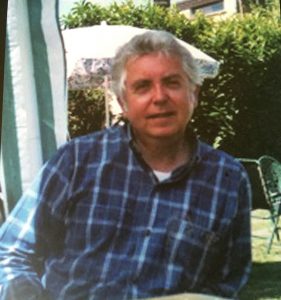
Keith Page
Inspired by the great British comics artists of the past such as Frank Hampson, Don Lawrence and Joe Colquhoun, Keith Page has worked full-time in comics and illustration for some 17 years. Subjects have ranged from television-related material such as Thunderbirds, science fiction, and his current war stories of all periods for Commando.
Along with many Charlotte Corday-related projects, recent works include The Casebook of Bryant May: The Soho Devil written by Christopher Fowler.
• A variety of Keith’s work can be seen on www.keithpageukcomicsartist.blogspot.com and Charlotte Corday has a dedicated web site at www.charlotte-corday.com
The founder of downthetubes, which he established in 1998. John works as a comics and magazine editor, writer, and on promotional work for the Lakes International Comic Art Festival. He is currently editor of Star Trek Explorer, published by Titan – his third tour of duty on the title originally titled Star Trek Magazine.
Working in British comics publishing since the 1980s, his credits include editor of titles such as Doctor Who Magazine, Babylon 5 Magazine, and more. He also edited the comics anthology STRIP Magazine and edited several audio comics for ROK Comics. He has also edited several comic collections, including volumes of “Charley’s War” and “Dan Dare”.
He’s the writer of “Pilgrim: Secrets and Lies” for B7 Comics; “Crucible”, a creator-owned project with 2000AD artist Smuzz; and “Death Duty” and “Skow Dogs” with Dave Hailwood.
Categories: Creating Comics, downthetubes Comics News, downthetubes News, Features
 The SEQUENT’ULL Interviews: Dan White
The SEQUENT’ULL Interviews: Dan White  The SEQUENT’ULL Interviews: Michelle Freeman
The SEQUENT’ULL Interviews: Michelle Freeman  The SEQUENT’ULL Interviews: Colossive Press
The SEQUENT’ULL Interviews: Colossive Press  The SEQUENT’ULL Interviews: Comic Creator Mark Stafford
The SEQUENT’ULL Interviews: Comic Creator Mark Stafford